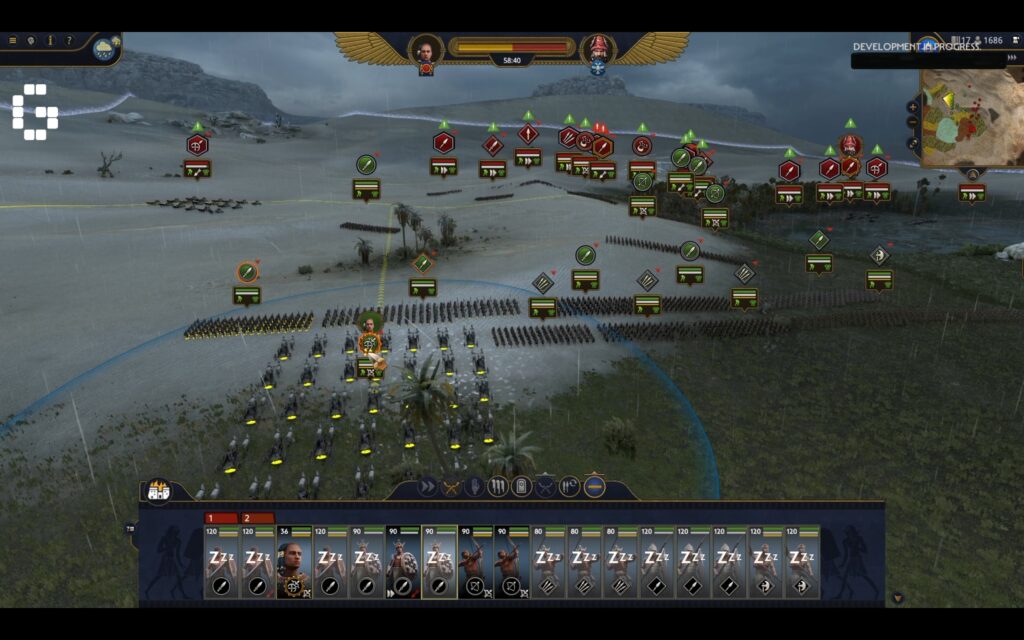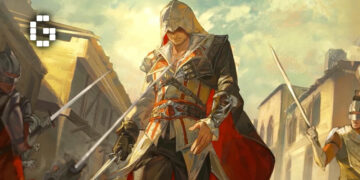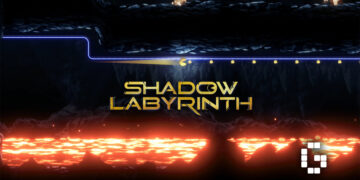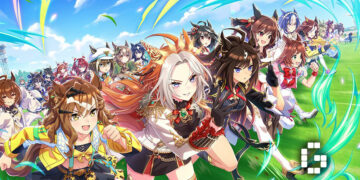We got the chance to interview two of the leads on the upcoming historical strategy game Total War: Pharaoh, Game Director Todor Nikolov, and Battle Designer Hristo Enev.
As you can imagine from the makers of Total Wars, the two were very much into history. Many of their answers to our interview questions for Total War: Pharaoh were honestly less like answers and more full-on history lectures about Bronze Age empires. It was fascinating and gave us a greater insight into how Total War decides on a setting and creates an authentic warfare experience.
Todor Nikolov started as a QA tester before becoming a full-on game designer. Upon joining Creative Assembly, he worked on the Total War: ROME II DLC Empire Divided before being appointed to the position of Lead Game Designer for Rise of the Republic DLC. Afterward, he performed the same role on Total War Saga: Troy and is now the director for Total War: Pharaoh.
Hristo Enev started at Creative Design over five years ago, working almost exclusively as a QA technician for Total War Saga: Troy. After the game’s release, he became a Battle Designer for the Troy Mythos DLC and will be doing the same for Pharaoh.
In this interview, the two told us more about why they chose Ancient Egypt for the next Total
War game and what they hope to add in Pharaoh in terms of historical immersion and improving on past gameplay mechanics.
Why Ancient Egypt?
In many ways, the decision to bring the Total War series to Ancient Egypt isn’t surprising. The land of the Pharaohs remains an ever-popular historical setting for many games, movies, and other pieces. With over a thousand years of dynasties and monarchs, however, it can be difficult to decide on what period in Egypt to go for. Todor explained that the team decided on the end of The New Kingdom as they believed it would be the best fit for a Total War setting thanks to Egypt’s military campaigns extending into the wider region.
“Older periods did not have a sufficient amount of military technology to represent a Total War game in an interesting way. This is what naturally drew us towards the New Kingdom Period because at that point the Egyptians had chariots”.
“Taking a look at the new kingdom, we went through the various periods and various important pharaohs, and finally, we decided to go with the late bronze age which comes at the end of the New Kingdom and it ticked a lot of boxes. It is fitting to be the setting of a Total War title because by this point Egypt is no longer confined to the banks of the Nile. It extends far away and in addition, there are other empires, there is also the Hittite Empire and they have their own enemies that they need to defend themselves against. Egypt is constantly at war with the raiding Nomad Desert and Sea Peoples while there are mountain tribes that are threatening the Hittite Empire”.
The crux of the decision was essentially to find an era when Egypt was truly at Total War both internally and with neighboring Kingdoms, all in one of the most chaotic areas in antiquity.
The Bronze Age Collapse

The Bronze Age Collapse is an event that saw multiple Empires in ruin due to a number of political, and economic problems as well as having to deal with invading groups.
“During this period, both of these empires [Egyptian Empire and Hittite Empire] have their share of internal strife,” says Todor “We’re representing the collapse of The Bronze Age, it’s a historical term that describes the way in which most of the civilizations in this part of the world got completely destroyed. Egypt was an exception because of Ramses III [who is playable in the game]. He managed to repel the invaders, The Sea Peoples, who tried to threaten Egypt and in this way ensure the survival of Egypt”.
Todor notes that creating the feeling of The Bronze Age Destruction was an important aspect of the game which can be seen in the changing maps and battlefields.
“After the Bronze Age collapsed, it was kind of an apocalyptic landscape with destroyed settlements and ruins. After that, there were a couple of centuries of dark ages, and Egypt survived through those only by virtue of Ramses III. This is what we chose the believe and this is how we chose the represent it in the game”.
“So, all in all, we have these magnificent civilizations that are about to collapse and there are external invaders that are coming from across the sea, bringing destruction. There are internal civil wars and this all combines to create an excellent Total War setting”.
Meet The Hittites

It’s not just Ancient Egypt who are playable in the game, Todor also told us more about the other two factions that are playable in the game: The Hittites and The Canaanites. Starting with the former he explained that the Hittites were an enigmatic group with a long history in the region.
“The Hittite Empire of Ancient Anatolia (Turkey) is a very enigmatic civilization. One of the things I find particularly interesting is that we got to learn that they existed relatively late. Like everyone knows about the Ancient Egyptians but Hittites were discovered somewhere in the 20th century so it’s very late. Before that, they were mentioned in the Bible and all of a sudden scientists discovered, yes these were actual people, they lived in Anatolia and they built magnificent stone settlements and worshiped their specific gods”.
“They were pretty influential, at some point, they aggressively expanded and clashed with Egypt, there is a very famous battle near the city of Kadesh where the forces of Ramses II and the Hittites went into a battle, and both sides claimed victory”.
Unlike Egypt, they didn’t survive the Bronze Age Collapse however that doesn’t mean they weren’t a powerful foe. The Team aimed to showcase them as accurately as possible in terms of units, characters, and playstyle.
“We want the game to represent both the way they fought, the settlements they lived in, and the relationships between their different rulers. They were a great empire, but they did not survive the bronze age collapse. In fact, you will have the chance to play as Suppiluliuma, their last great king who we believe put everything that he could towards protecting his people and keeping his empire together but he seems to have failed”.
Meet The Canaanites

The final faction in the game is the Canaanites. Unlike Egypt and the Hittite Empire, the Canaanites are not a single political entity but rather comprised of small kingdoms and city-states, inhabiting an area on the Eastern Coast of the Mediterranean. Because they were sandwiched between the Egyptians in the South and the Hittites in the North, they’re framed as a more flexible group and can more easily adapt to different situations.
“The Canaanites found different ways to survive. They would often use the cultural influence of the great empires that controlled them to their advantage. Back in the bronze age, the pharaohs had periodical expeditions where they would visit their Canaanite dominions to make sure they still paid their tribute. The Canaanites would show to be obedient but then they would not always pay what they owed the pharaoh”.
In the game, this is represented by the Caananites being a middle ground between agile Egypt and the tankier Hittites. Whether this makes them a jack of all trades or a master of none will come down to the player.
Will Total War: Pharaoh Have Fantasy Elements?

One of the bigger questions that Total War fans may have about Pharaohs is whether it will have any fantasy aspects. While the series is primarily known for recreating historical settings, the previous games have been collaborations with the Warhammer fantasy series, and even the previous historical title, Total War: Three Kingdoms, contained fantastical elements.
Old-school fans should rest assured however as Todor has confirmed that Pharaoh will have a full historical setting with no supernatural parts.
“With Pharaoh, we are aiming to represent the Bronze Age Peroid in a historically authentic way so there are no fantastical or mythological elements. For example, we have an aspect of the game related to the bronze age religion but we are representing the people worshipping the gods and how the people’s faith affects them and their thinking. We’re not featuring any supernatural beings that would directly appear somewhere and affect the game in any palpable way”.
War Across The Desert

From here, the developers spoke more about the game’s battle system with Hristo talking about the different units that can be expected in the game.
“As Todor said, we are aiming at historical authenticity with the game, no supernatural creatures. With it, there are a number of changes since most of your units are infantry, we’ve divided those into different groups or categories. You have more diversity to choose different spears and shields, maybe if they’re Hittie they have heavy armor so they are even better at defending a line”.
He says that several types of weapons will be present in the game including swords, ranged weapons like javelins and Nubian Longbows, and of course, chariot units. Each of these is further split it light, heavy, and medium-style weapons that work better against certain enemies and in certain environments.
“The Hittites tended to use heavier chariots while the Egyptians mostly used lighter chariots used in sandy areas with ranged weapons and they use them more like skirmishing units. They get close to the enemy, they shoot and they move back. That’s how we represent them in the game as well. There is a middle ground with the medium chariots which are not as melee-focused as the Hittite chariots and they’re not as fast and agile as the light chariots”.
Navel Battles
Considering the importance of the River Nile in Ancient Egypt, we also asked Todor if there would be any naval battles in the games. He says that if two ships meet on the water, they’ll go to land to have the battle.
“Navel battles in the game are going to be represented in the same way that they were represented in Total War Troy and in Total War Warhammer which means that when armies meet somewhere that is seaborne or in the River Nile which is a sea of its own, they will disembark from their ships and they will wage a land battle”.
Laying Siege

Hristo also went into more detail about siege battles, where the player is tasked with capturing a settlement, or fortress. These include new siege ladders, siege towers, and battering rams to give better options for breaking passed the walls.
They will also be adding multiple victory points that must all be acquired for victory. This was to make the game more challenging compared to previous games where there was only one victory point.
“In previous total war games, there was one victory point. When you attack a settlement you tend to get inside a settlement, and probably rush towards the victory point, capture that, and wait for the timer to go and then win the battle.
“We changed that to have siege battles involve three victory points and minor settlements have two victory points so in order to win the battle you need to have all three or at least two along with the defender’s morale breaking because you control more of the settlement. Each of these victory points also has an effect on its own for example if you have a marketplace, that is an important part of the settlement and it provides a moral bonus to whoever controls it”.
At the start of the battle, the defender holds all victory points, giving them an advantage. The attacker will have to work to find weaknesses in their defense and think about how to exploit them.
Building The Pyramids

Since this interview was primarily about the battle system, we didn’t ask too much about the construction and diplomacy aspect of the game however, we were about the learn more about the Pyramids. Being one of the most iconic images of Ancient Egypt, Todor says they will be visible on the overworld map and that players will have the opportunity to build their own.
“You will be able to construct buildings in some places on the campaign map. In addition to that, in other circumstances, you might choose to build a pyramid of your own which is not accurate for this historical period because nobody had the resources to construct a pyramid but we felt that if the players choose to have their own pyramid as a pharaoh, they should be able to do that”.
“Also, the Great Pyramid of Giza will be featured on the campaign map along with the Sphinx as well as other well-recognizable Egyptian monuments and famous places like the Valley of the Kings so you will be able to see those”.
Feedback From Past Games

The last Total War developed was Total War: Warhammer III a well-received strategy game that was successful for Creative Assembly but as with everything, there’s always room for improvement. In terms of feedback from that game, Todor said one of the main aspects they improved on was adding matched combat animation for greater immersion.
“We have taken into account a lot of user feedback from various sources. A lot of that feedback made its way into the game in the form of fixes and new features. One of the feedback was that players would like the see-matched combat animations because they significantly increase the immersion and make the battles more spectacular in general. We implemented those in the game so now there are matched combat animations for all units in the game.
They have also updated the siege mechanics in the game, removing the disliked “pocket ladders” in favor of full-on siege towers.
“Another aspect we got from player feedback is related to the sieges and siege equipment. We decided to remove the so-called ‘pocket ladders’ so when you’re attacking a settlement and your unit marches against the wall and they get out ladders, out of thin air. This felt immersion-breaking for a lot of people which is why you’ll no longer do that, you have to have siege towers which are replacing the pocket ladders. They’re quick to construct but they’re not well-armored so if you choose to attack the settlement quickly you risk the life of your men”.
Final Message

To end the interview, we asked Total War: Pharaoh if they had any final message for the fans. Hristo said that he hopes players “experience the authenticity of the period” and Todor gave a larger comment saying that he hopes fans enjoy the greater sense of freedom from the sandbox gameplay that has also played a park in Total War.
“I would like to point out to the fans that the sandbox has always been the core of the Total War experience. With the boundaries of the sandbox, we want to give the plates freedom of choice in various ways. In campaigns, you can decide to be the Pharaoh or the Great King of The Hittites or not be either and do your own thing, whatever it is. You might choose to protect Egypt or destroy Egypt. We’re also providing you with additional campaign options that you can tweak and play. So my message to the fans would be to enjoy the game and play it in the way that they want to play it”.

We thank Todor and Hristo for speaking to us about Total War: Pharaoh for this interview. As I mentioned at the beginning, I could sense the passion these guys had for history as they explained each question, they truly seemed invested in bringing New Kingdom Ancient Egypt to life. Considering fans have been itching for another fully historical Total War game, this passion should hopefully shine through and lead to a great new age for Total War.
Total War: Pharaoh is available for PC via Steam and The Epic Game Store.
For more information on the game, check out our preview where we go over its setting and gameplay in more detail.












![[EXCLUSIVE] Creative Masterminds from Gearbox Software Reveal What Makes Borderlands 4 Worth the Wait](https://cdn.gamerbraves.com/2025/07/Borderlands-4-at-Bilibili-World-2025_Interview_FI-360x180.jpg)




![[ASIA EXCLUSIVE] Bringing Back a Classic: Inside the Making of FINAL FANTASY TACTICS – The Ivalice Chronicles](https://cdn.gamerbraves.com/2025/06/FFT-Ivalice-Chronicles_Interview_FI2-360x180.jpg)














